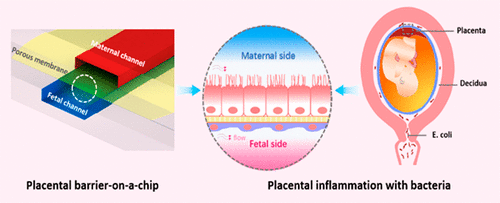当前位置:
X-MOL 学术
›
ACS Biomater. Sci. Eng.
›
论文详情
Our official English website, www.x-mol.net, welcomes your
feedback! (Note: you will need to create a separate account there.)
Placental Barrier-on-a-Chip: Modeling Placental Inflammatory Responses to Bacterial Infection
ACS Biomaterials Science & Engineering ( IF 5.4 ) Pub Date : 2018-07-16 00:00:00 , DOI: 10.1021/acsbiomaterials.8b00653 Yujuan Zhu 1, 2, 3 , Fangchao Yin 2, 3 , Hui Wang 2, 3 , Li Wang 2 , Jingli Yuan 1 , Jianhua Qin 2, 3, 4
ACS Biomaterials Science & Engineering ( IF 5.4 ) Pub Date : 2018-07-16 00:00:00 , DOI: 10.1021/acsbiomaterials.8b00653 Yujuan Zhu 1, 2, 3 , Fangchao Yin 2, 3 , Hui Wang 2, 3 , Li Wang 2 , Jingli Yuan 1 , Jianhua Qin 2, 3, 4
Affiliation

|
Placental inflammation, as a recognized cause of preterm birth and neonatal mortality, displays extensive placental involvement or damage with the presence of organisms. The inflammatory processes are complicated and tightly associated with increased inflammatory cytokine levels and innate immune activation. However, the deep study of the underlying mechanisms was limited by conventional cell and animal models because of great variations in the architecture and function of placenta. Here, we established a microengineered model of human placental barrier on the chip and investigated the associated inflammatory responses to bacterial infection. The multilayered design of the microdevice mimicked the microscopic structure in the fetal-maternal interfaces of human placenta, and the flow resembled the dynamic environment in the mother’s body. Escherichia coli (E. coli), one of the predominant organisms found in fetal organs, were applied to the maternal side, modeling acute placental inflammation. The data demonstrated the complex responses including the increased secretion of inflammatory cytokines by trophoblasts and the adhesion of maternal macrophages following bacterial infection. Particularly, transplacental communication was observed between two placental cells, and implied the potential role of trophoblast in fetal inflammatory response syndrome in clinic. These complex responses are of potential significance to placental dysfunctions, even abnormal fetal development and preterm birth. Collectively, placental barrier-on-a-chip microdevice presents a simple platform to explore the complicated inflammatory responses in human placenta, and might help our understanding of the mechanisms underlying reproductive diseases.
中文翻译:

芯片胎盘屏障:对细菌感染的胎盘炎症反应建模
作为早产和新生儿死亡的公认原因,胎盘发炎表现出广泛的胎盘受累或存在生物体的损害。炎症过程很复杂,并且与炎症细胞因子水平升高和先天免疫激活密切相关。然而,由于胎盘的结构和功能的巨大差异,对潜在机制的深入研究受到了常规细胞和动物模型的限制。在这里,我们在芯片上建立了人类胎盘屏障的微工程模型,并研究了对细菌感染的相关炎症反应。微设备的多层设计模仿了人类胎盘胎儿-母亲界面的微观结构,其流动类似于母亲体内的动态环境。大肠杆菌(大肠杆菌)是在胎儿器官中发现的主要有机体之一,被应用于产妇一侧,模拟了急性胎盘发炎。数据证明了复杂的反应,包括滋养细胞增加了炎性细胞因子的分泌以及细菌感染后母体巨噬细胞的粘附。特别是,在两个胎盘细胞之间观察到了胎盘通讯,这暗示了滋养细胞在临床中胎儿炎症反应综合征中的潜在作用。这些复杂的反应对胎盘功能障碍,甚至异常的胎儿发育和早产具有潜在的重要意义。总的来说,胎盘芯片上微障碍器提供了一个简单的平台来探索人类胎盘中复杂的炎症反应,
更新日期:2018-07-16
中文翻译:

芯片胎盘屏障:对细菌感染的胎盘炎症反应建模
作为早产和新生儿死亡的公认原因,胎盘发炎表现出广泛的胎盘受累或存在生物体的损害。炎症过程很复杂,并且与炎症细胞因子水平升高和先天免疫激活密切相关。然而,由于胎盘的结构和功能的巨大差异,对潜在机制的深入研究受到了常规细胞和动物模型的限制。在这里,我们在芯片上建立了人类胎盘屏障的微工程模型,并研究了对细菌感染的相关炎症反应。微设备的多层设计模仿了人类胎盘胎儿-母亲界面的微观结构,其流动类似于母亲体内的动态环境。大肠杆菌(大肠杆菌)是在胎儿器官中发现的主要有机体之一,被应用于产妇一侧,模拟了急性胎盘发炎。数据证明了复杂的反应,包括滋养细胞增加了炎性细胞因子的分泌以及细菌感染后母体巨噬细胞的粘附。特别是,在两个胎盘细胞之间观察到了胎盘通讯,这暗示了滋养细胞在临床中胎儿炎症反应综合征中的潜在作用。这些复杂的反应对胎盘功能障碍,甚至异常的胎儿发育和早产具有潜在的重要意义。总的来说,胎盘芯片上微障碍器提供了一个简单的平台来探索人类胎盘中复杂的炎症反应,











































 京公网安备 11010802027423号
京公网安备 11010802027423号